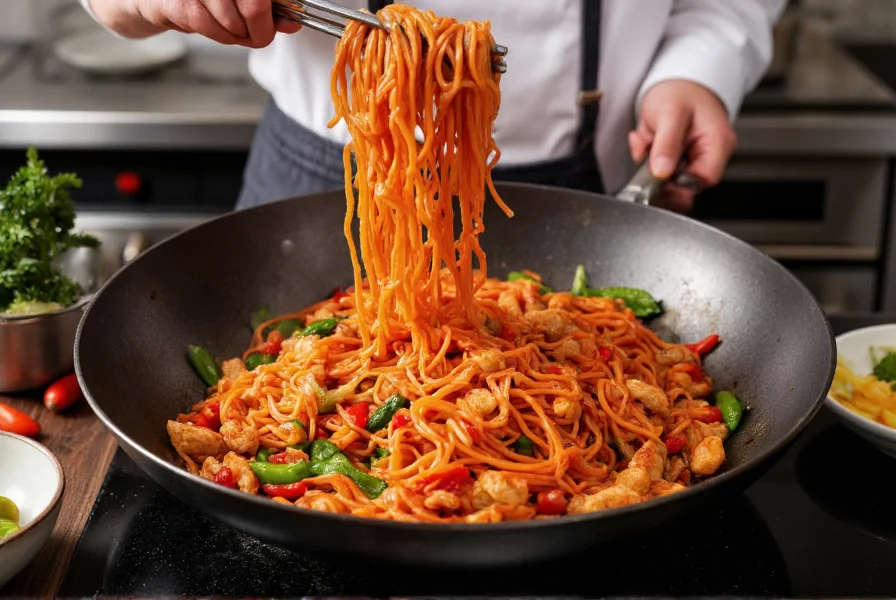These vibrant strands have become increasingly popular in fusion cuisine worldwide. While many assume red pepper noodles are extremely spicy, most commercial varieties offer a mild warmth rather than intense heat, making them accessible to a wide range of palates. The color comes from natural carotenoids in the peppers, not artificial dyes, providing both aesthetic appeal and potential health benefits from capsaicin and antioxidants.
The Unique Characteristics of Red Pepper Noodles
What sets red pepper noodles apart from standard varieties goes beyond just appearance. The incorporation of red pepper powder affects multiple aspects of the noodle experience:
| Characteristic | Red Pepper Noodles | Regular Wheat Noodles |
|---|---|---|
| Color | Vibrant orange-red | Yellowish-white |
| Flavor Profile | Subtle warmth with earthy pepper notes | Neutral, wheat-forward |
| Texture | Slightly firmer due to pepper content | Standard chewiness |
| Nutritional Value | Added capsaicin, vitamin A, antioxidants | Basic carbohydrate profile |
The specific red pepper variety used significantly impacts the final product. Korean gochugaru provides a complex flavor with both heat and sweetness, while Chinese chili flakes might deliver a sharper, more direct spiciness. Japanese versions often use milder peppers for a more subtle effect. This regional variation creates diverse culinary possibilities for red pepper noodle recipe ideas across different cooking traditions.

Cultural Origins and Culinary Evolution
While often associated with modern fusion cuisine, red pepper noodles have deep roots in East Asian cooking traditions. Korean cuisine features gochugaru-infused noodles in dishes like naengmyeon variations, where the pepper adds complexity to the cold noodle soup. Chinese culinary history shows evidence of pepper-colored noodles dating back to the Ming dynasty, though these were initially made with saffron before chili peppers arrived via trade routes.
The modern popularity of red pepper noodles exploded in the late 20th century as global food exchange increased. Chefs discovered that the visual drama of the vibrant color combined with the gentle warmth made these noodles perfect for contemporary plating and flavor balancing. Today, they appear in everything from high-end restaurant dishes to convenient instant noodle packets, answering the growing consumer question about where to buy red pepper noodles in mainstream markets.
Types of Red Pepper Noodles Available
Not all red pepper noodles deliver the same experience. Understanding the different varieties helps you select the right type for your culinary needs:
- Fresh red pepper noodles - Typically found in Asian markets, these have the most vibrant color and freshest flavor but shorter shelf life
- Dried red pepper noodles - Most common in supermarkets, offering longer storage while maintaining decent color and flavor
- Instant red pepper noodle varieties - Pre-cooked and dehydrated, often with additional seasoning packets
- Homemade red pepper noodles - Allow complete control over pepper type, quantity, and noodle texture
When comparing red pepper noodles vs regular noodles, consider that the pepper content affects cooking time. The additional ingredients can make them slightly more delicate, requiring careful attention during boiling to prevent overcooking. Premium varieties maintain their striking color throughout cooking, while lower-quality versions may bleed color into the water.
Mastering Red Pepper Noodle Preparation
Proper preparation makes all the difference in showcasing red pepper noodles at their best. Follow these professional techniques for optimal results:
- Use plenty of well-salted water (4-6 quarts per pound of noodles)
- Bring water to a full rolling boil before adding noodles
- Cook for 1-2 minutes less than package instructions suggest
- Reserve 1 cup of starchy cooking water before draining
- Immediately rinse under cold water to stop cooking and enhance color vibrancy
- Toss with a small amount of neutral oil to prevent sticking
The reserved starchy water proves invaluable when creating sauces, as it helps emulsify and cling to the noodles. This technique works particularly well for red pepper noodle stir fry recipes where sauce adherence is crucial. Unlike regular noodles, red pepper varieties benefit from a quick ice water bath after cooking to preserve their striking color.

Perfect Pairings for Red Pepper Noodles
Certain ingredients elevate red pepper noodles from simple carbohydrates to memorable dishes. Consider these pairing principles when developing your red pepper noodle recipe ideas:
Protein partners: Shredded chicken, thinly sliced beef, tofu, shrimp, or poached eggs complement the noodles' flavor profile without overwhelming it. The mild heat of the noodles works particularly well with proteins that have been marinated in ginger and garlic.
Sauce considerations: While soy-based sauces remain popular, consider balancing the pepper's warmth with cooling elements like sesame oil, rice vinegar, or a touch of honey. Creamy sauces with coconut milk create an interesting contrast that appeals to those wondering about red pepper noodles mild heat level.
Vegetable companions: Bok choy, bean sprouts, scallions, and shredded carrots add texture contrast and visual appeal. For those exploring red pepper noodle health benefits, adding broccoli, bell peppers, and mushrooms boosts nutritional value while complementing the existing flavor profile.
Storage and Shelf Life Guidelines
Proper storage maintains both the visual appeal and flavor integrity of red pepper noodles:
- Fresh noodles: Store in the refrigerator for 2-3 days in an airtight container with a light dusting of cornstarch to prevent sticking
- Dried noodles: Keep in a cool, dark pantry for up to 12 months in their original packaging or an airtight container
- Cooked noodles: Refrigerate for 3-4 days with a small amount of oil to prevent clumping
- Freezing: Cooked noodles freeze well for up to 2 months when portioned and separated by parchment paper
When reviving cooked noodles, avoid reheating in plain water as this can leach color and flavor. Instead, briefly dip in hot water or toss directly in a hot wok with sauce. This method preserves the distinctive characteristics that make red pepper noodles unique among specialty pasta varieties.











 浙公网安备
33010002000092号
浙公网安备
33010002000092号 浙B2-20120091-4
浙B2-20120091-4